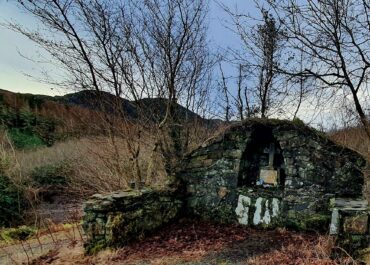Bullaun stone, An Sruthán Riach, Co. Donegal
At the summit of a steep, west-facing hillside in County Donegal's pastureland sits an intriguing piece of early Irish heritage known locally as St. Begley's Knee Stone.
Bullaun stone, An Sruthán Riach, Co. Donegal
This ancient site features two basin-like depressions carefully carved into the natural rock surface, positioned just 6 centimetres apart. The larger depression measures 23 centimetres across and 14 centimetres deep, whilst its smaller companion spans 18 centimetres with a depth of 5 centimetres. These hollowed-out cavities are examples of bullaun stones, mysterious rock-cut basins found throughout Ireland that likely served ritual purposes in early Christian times.
The site at An Sruthán Riach offers more than just these carved depressions. Beside them, an upright stone edge barely breaks the surface of the ground, clearly placed there deliberately rather than occurring naturally. This positioning suggests the location held particular significance for the local community, possibly as a place of pilgrimage or healing. The name ‘St. Begley’s Knee Stone’ hints at folk traditions that may have associated the depressions with acts of devotion, perhaps where pilgrims would kneel in prayer or perform other religious observances.
Bullaun stones like these remain somewhat enigmatic in Irish archaeology. Whilst many are found near early Christian sites and holy wells, their exact purpose continues to spark debate amongst historians. Some theories suggest they were used for grinding grain or herbs, others propose they held holy water for blessings and cures, and still others believe they played a role in pre-Christian rituals that were later absorbed into local Christian practices. Whatever their original function, St. Begley’s Knee Stone stands as a tangible link to the spiritual landscape of medieval Donegal, weathering centuries atop its hillside perch.


